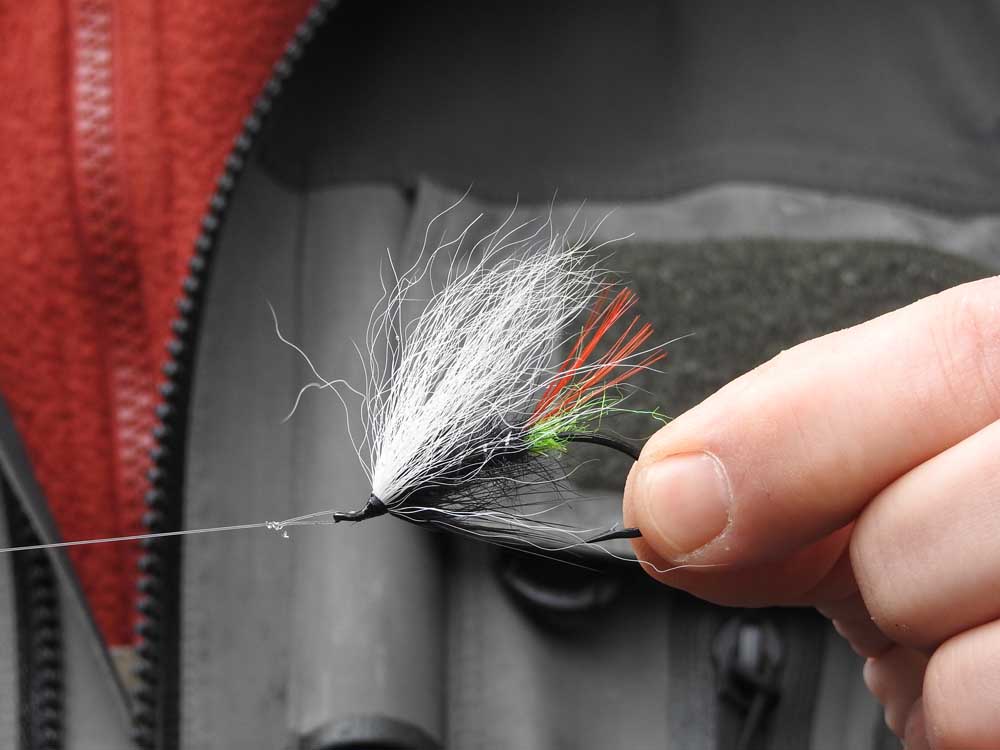A wild steelhead sanctuary in Steamboat Creek
Published 12:00 am Monday, April 1, 2019

- A variation of the Green Butt Skunk employs a white calf tail wing. The Green Butt Skunk is one of the best-known steelhead patterns. (Gary Lewis/For The Bulletin)
When Travis Woodward stood up from the tying table in the library, I took his place. A lot of flies have been tied in this room at Steamboat Inn. I would tie a Green Butt Skunk.
Into the jaws of the vise I clamped a steelhead hook and tied down a red hackle fiber tail, a chartreuse chenille butt and finished with black chenille, silver floss, a skunk hair wing and black schlappen.
When our flies were finished, Woodward, Dean Finnerty, Tim Wehde and I took two-handed rods to the river.
There is no Western reach more storied than the North Umpqua’s fly water. Snowmelt runs down out of the Cascades through channels cut in bedrock. The river’s long pools, falls and runs have changed little since Zane Grey cast a silken line and feathered temptation on a split cane rod in the camp water.
It is a river reputed to change the anglers who fish it with experiences that can be described as religious. It changed Hemingway and Haig-Brown, Ernie Schwiebert and many others over the last century.
Dean Finnerty counts himself among the people touched by the North Umpqua. Finnerty drove up from his home on the main stem Umpqua to spend a morning with us in the fly-fishing-only section of the river.
This section of river, over 30 miles long, is designated fly-fishing-only, Finnerty reminded us, due in part to the efforts of Frank Moore, the North Umpqua’s legendary angler, and his wife, Jeanne.
Moore, a World War II veteran, began fishing the North Umpqua in 1946. He and wife Jeanne bought a café on the upper river in 1957 and turned it into the Steamboat Inn. Frank and Jeanne still live on the North Umpqua.
Moore’s accomplishments include helping to found the Steamboaters, a conservation organization, and advocating for passage of the Forest Practices Act. Moore, who was on the beach in Normandy in ’44, knows how healing these waters are for veterans. And that’s part of the reason he was happy to have his name attached to a new sanctuary for steelhead in the Steamboat Creek watershed.
There was a time when the North Umpqua was one of the best trout fishing rivers in the West. Dams, on the upper river at Soda Springs and at Winchester, have hurt the trout fishing, but the North Umpqua is still one of the world’s premier steelhead streams with both winter runs and summer-run fish. Now the North Umpqua’s steelhead will be protected in an extraordinary piece of public lands legislation that was signed into law by President Trump. It is called the John D. Dingell Jr. Conservation, Management and Recreation Act and it contains 170 separate provisions, including the new Frank and Jeanne Moore Wild Steelhead Sanctuary.
The sanctuary comprises 99,653 acres of the Steamboat Creek watershed. Picture the mouth of Steamboat Creek, the confluence at Highway 138. The boundary runs ridge tops to the north, well to the east and deep into Lane County, almost 100,000 acres of forest. But this is not a wilderness designation.
Finnerty was quick to point out that fish values come first in this sanctuary. Hunters, hikers, mountain bikers and berry pickers will still be able to use the roads and the trails.
One spot where people can see steelhead in the clear water is at the Big Bend Pool, 12 miles up Steamboat Creek. Some 600 to 800 steelhead hold in Steamboat until the fall rains come, when they start to seek out their home creeks where they will spawn in late winter.
“Those fish really have to have someplace they can go to find that cool water to survive during the summer months,” Finnerty said. “Water quality and water temperature are first and foremost.”
And those values — fish values — will inform management of these 100,000 acres for perpetuity.
Senators Ron Wyden and Jeff Merkley and congressman Peter DeFazio championed the bill, and the Wild Salmon Center, Pacific Rivers and Trout Unlimited were important carriers of the message. President Trump signed the bill into law last month.
To swing for steelhead, the angler casts quartering-downstream, throws an upstream mend and lets the fly scribe a slow arc across the current. If a fish plucks at the fly, the angler lets it take line before lifting the rod to set the hook. We cast, mended, swung and two-stepped downriver to swing again. Finnerty had a fish take the fly, but he didn’t connect.
The mind plays back many fish brought to hand. A 19-pound winter-run taken on side-drifting gear near Glide. An 8-pound wild summer fish caught and released on a swung fly in a run called the Flats. And Geoff Hill’s fish of the same morning, teased up between two boulders to pluck at the offering and turn in the clear water, streaking downstream with the bit of fur and feather stuck in the corner of its mouth, line burning off the reel.
— Gary Lewis is the host of “Frontier Unlimited TV” and author of “Fishing Central Oregon,” “Fishing Mount Hood Country,” “Hunting Oregon” and other titles. Contact Gary at www.GaryLewisOutdoors.com






